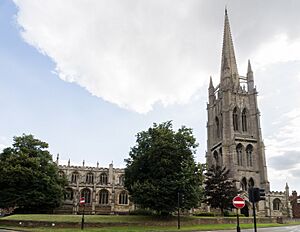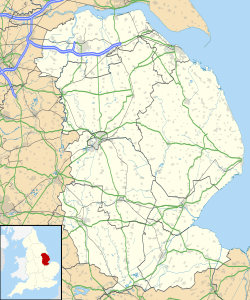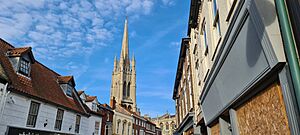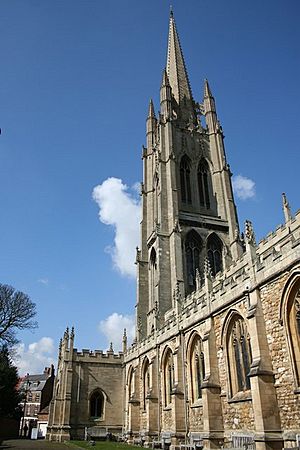St James' Church, Louth facts for kids
Quick facts for kids St James' Church, Louth |
|
|---|---|
| St James' Church | |

The church and its spire
|
|
| 53°22′00″N 0°00′29″W / 53.3666°N 0.0080°W | |
| Location | Louth, East Lindsey |
| Country | England |
| Denomination | Church of England |
| Churchmanship | Broad Church |
| Website | St James' Church |
| History | |
| Status | Active |
| Dedication | James, son of Zebedee |
| Architecture | |
| Functional status | Active |
| Heritage designation | Grade I listed |
| Years built | 1430–1440 (Church was built), 1515 (Spire was built and completed) |
| Specifications | |
| Length | 182 feet (55 m) |
| Spire height | 287 feet 6 inches (87.63 m) |
| Administration | |
| Parish | Louth |
| Deanery | Louthesk |
| Archdeaconry | Lincoln |
| Diocese | Lincoln |
| Province | Canterbury |
St James' Church in Louth, England, is a very old and important church. It belongs to the Church of England. This church is famous for its super tall spire, which is the third tallest in the entire United Kingdom! The church was also a key place for the Lincolnshire Rising in October 1536. This event was a protest against changes made by King Henry VIII.
Contents
History of the Church
Building the Church and Spire
St James' Church is a medieval building, meaning it's very old. It has the tallest stone steeple of any medieval parish church in Britain. The stone part of the spire is about 287 feet (87 meters) tall. If you include the weather vane on top, it reaches about 293 feet (89 meters)!
The main parts of the church, the chancel and nave, were rebuilt between 1430 and 1440. The tower was started around the 1440s or 1450s. It was finished by 1499.
Work on the amazing spire began in 1501. It took 14 years to finish, finally completed in 1515. The weathercock, a metal rooster that shows wind direction, was placed on top on September 13, 1515. This weathercock was special. It was made in Lincoln from a large copper basin. This basin was taken from the Scots after a battle in 1513 called the Battle of Flodden.
Earlier Churches on This Site
This church is actually the third one built on this spot. The first two churches were from the 11th and 13th centuries. The current church, mostly from the 15th century, replaced them. In its early days, the church had five smaller chapels and altars. It also had a tall, three-story screen called a rood screen.
The Lincolnshire Rising
In October 1536, something big happened at the church. People gathered there to start the Lincolnshire Rising. This was a protest against King Henry VIII's changes to the church. This uprising was followed by another one called the Pilgrimage of Grace. Sadly, neither protest worked. The king's forces took away many valuable things from the church, including the rood screen.
Restorations and Discoveries
The roof of the nave was replaced in 1825. The spire was repaired and made new between 1844 and 1845 by Lewis Nockalls Cottingham. More restoration work happened from 1861 to 1869. This was done by James Fowler, who was known as 'Fowler of Louth'. During this time, the church got new oak seats and a beautifully carved pulpit. The floors were laid with special tiles. A new heating system was also put in. The church reopened on August 5, 1869.
In 1937, the church flew the highest flag in Lincolnshire to celebrate the coronation of King George VI. Later that year, more work was done on the spire.
In 2015, researchers found two pieces of a very old stone cross in the Rectory garden. This cross dates back to around 950 AD. It is a "ring" or "wheel head" type cross, similar to those often seen in Ireland. The main design on the cross shows Christ crucified. This special cross is now on display inside the church.
In 2017, money was raised to add a viewing door to a small room below the spire floor. This room holds the original medieval treadwheel. This huge wheel was used to lift stones and mortar when the spire was being built (1501–1515). It was known as The Wild Mare. This is a very rare survival from that time!
Dedication
The church is named after James, son of Zebedee. In the Middle Ages, this saint was very important. Many people went on a long journey, called a pilgrimage, to visit his shrine in Santiago de Compostela, Spain.
Church Leaders
In 1859, the role of the vicar changed. It was combined with another church position, and the church leader became known as the Rector of Louth. Since 1974, the Rector of Louth has been the Team Rector for a group of churches in the area.
Bells
St James' Church has eight bells. They were remade in 1726. In 1798, the largest bell cracked! This happened when it was rung to celebrate Nelson's victory in the Battle of the Nile. The bells were rehung in 1957, and some were recast. They were refurbished and rehung again in 2022.
Tower Clock
The clock in the tower was put in place in 1846. It was made by Benjamin Vulliamy. This clock was expected to last for 200 years! It started working on July 25, 1846.
However, it was replaced in August 1901 by a new clock. This one was made by Leonard Hall of Louth. It chimes the famous Westminster chimes every 15 minutes. The hammer that strikes the hour bell weighs about 57 pounds (26 kg). The whole clock weighs about 1 ton (1,016 kg).
Organ
An organ was used to play music when the spire was officially opened in 1515. This organ had been brought from Flanders some years before. When it wore out in 1531, the townspeople wanted a new one. They gathered together, and a priest named Mr. Richard Taylor offered to help. He promised to get a new organ made for 22 pounds, and he would pay half! This new organ was made in Lyn and was placed in the church on June 10, 1531.
A new organ, made by Gray & Davison, was opened on December 17, 1857. It cost £800. This organ was changed in 1868-69. After being rebuilt again in 1911, it now has 37 stops and three keyboards, plus pedals.
Organists
Many talented people have played the organ at St James' Church over the years. Some famous organists who played here include Joseph Hill, John Hoyland, and Harold Dexter.
Visiting and Tourism
St James' Church is part of the Lincolnshire Church Tourism Network. This group helps people visit and learn about the many churches in Lincolnshire. Like other churches in this network, St James' has people called "stewards" there on weekdays. They can help you and guides are available until 4:00 PM. The west end of the church now has a tea shop, a book shop, and restrooms. It also provides information about other churches in the East Lindsey area.
Images for kids
-
Interior of the western tower or belfry.
-
Nave and chancel, viewed from the western end of the church.
-
Chancel of the church, viewed over the nave altar.
-
High altar of the church.
-
Altar of St Stephen's Chapel.
-
Plaque commemorating Lincolnshire Rising of 1536, opposite south entrance to church.




























